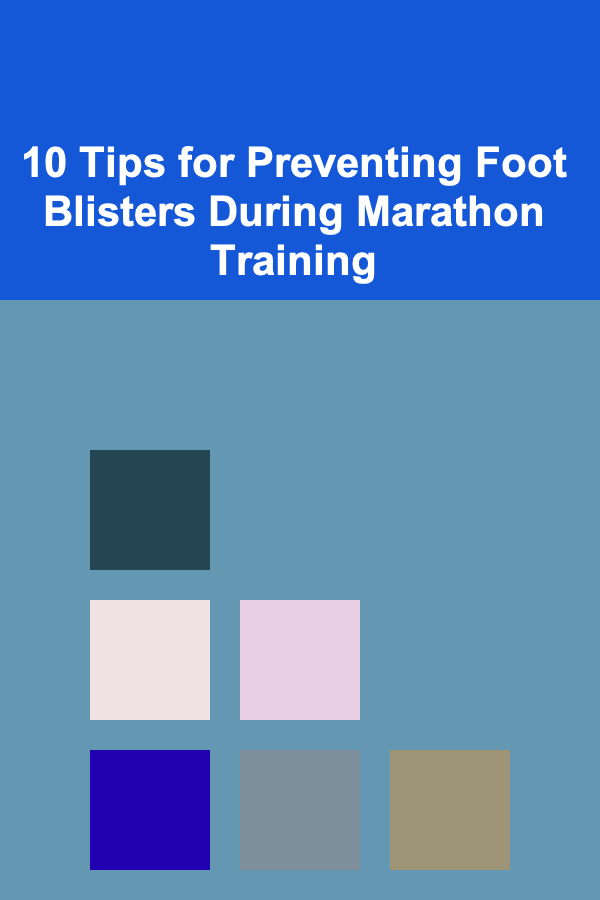
10 Tips for Preventing Foot Blisters During Marathon Training
ebook include PDF & Audio bundle (Micro Guide)
$12.99$7.99
Limited Time Offer! Order within the next:

Marathon training is a challenging yet rewarding journey. As you increase your mileage and push your limits, your body will undergo several physical adjustments. One of the most common and painful issues marathon runners face is foot blisters. These small, fluid-filled pockets of skin are caused by friction, moisture, and pressure, often resulting in discomfort that can derail your training. Preventing blisters is crucial not only for your training but also for your performance on race day.
In this article, we will cover ten practical tips for preventing foot blisters during marathon training. These strategies are designed to help you minimize friction, keep your feet dry, and maintain comfort during long runs. With the right preparation and attention to detail, you can reduce the likelihood of blisters and enjoy a more successful marathon journey.
Choose the Right Running Shoes
The foundation of blister prevention starts with the proper pair of running shoes. Ill-fitting shoes are one of the primary causes of blisters, so finding the right fit is crucial.
- Get a Proper Fit: Visit a specialty running store to have your feet properly measured. A running store expert can assess your foot type (flat, neutral, or high-arched) and recommend the shoes that are best suited for your gait and stride. Your running shoes should feel snug but not tight, with enough room in the toe box to wiggle your toes.
- Consider Shoe Size and Shape: Your running shoe size should be half a size larger than your regular shoe size to account for foot swelling during long runs. Also, consider shoes that match the shape of your foot. For example, if you have a wider foot, opt for shoes that offer more room in the forefoot area.
- Break Them In: Always break in new shoes before embarking on long runs. Wear them for short, easy runs to ensure they don't cause any immediate discomfort. Pay attention to any hot spots or areas where friction might develop.
Wear Moisture-Wicking Socks
Your choice of socks plays a significant role in blister prevention. Cotton socks trap moisture and cause excessive friction, which increases the risk of blisters. Instead, opt for moisture-wicking socks made from synthetic or merino wool fibers.
- Choose Synthetic or Merino Wool Socks: These materials are great for keeping your feet dry by drawing moisture away from the skin. Look for socks specifically designed for running, as they are often padded in areas that are prone to friction, such as the heel and toe.
- Avoid Cotton Socks: Cotton absorbs moisture and holds it against the skin, creating a perfect environment for blisters to form. Always choose socks that offer moisture control.
- Ensure a Proper Fit: Socks should fit snugly without excess material that could bunch up and cause friction. Seamless socks are a good option to avoid any rubbing or irritation at the seams.
Use Anti-Chafing Products
Chafing is not limited to your legs and arms; your feet can experience friction burns as well. Using anti-chafing products can create a barrier between your skin and your shoes, preventing blisters from forming.
- Apply Petroleum Jelly or Anti-Chafing Creams: Products like petroleum jelly, body glide, or specialized anti-chafing creams are designed to reduce friction. Apply these products to areas where blisters are likely to develop, such as the heel, toes, and the sides of your feet.
- Experiment to Find What Works for You: Not all anti-chafing products are created equal. Some runners prefer petroleum jelly, while others opt for more specialized balms. Try different options to see which one works best for your skin.
- Apply Before and During Runs: For maximum effectiveness, apply the product before your run and reapply during long runs if necessary.
Keep Your Feet Dry
Excess moisture is a leading cause of blisters. Sweating, rain, or wet conditions can make your feet more susceptible to friction. It's important to keep your feet as dry as possible during your marathon training.
- Use Foot Powder: Applying foot powder or cornstarch to your feet can help absorb excess moisture and reduce the likelihood of blisters. Pay attention to the areas between your toes, as moisture tends to accumulate there.
- Choose Breathable Shoes: In addition to wearing moisture-wicking socks, ensure that your running shoes are breathable. Shoes with mesh uppers allow air to circulate, which helps keep your feet dry.
- Avoid Running in Wet Conditions: If possible, avoid running in wet conditions or puddles, as wet shoes and socks will increase the risk of blisters. If you do run in the rain, change into dry socks and shoes as soon as possible afterward.
Gradually Increase Your Mileage
One of the main causes of blisters is the sudden increase in running distance, which can cause unnecessary stress and friction on your feet. By gradually increasing your mileage, you give your feet time to adjust to the demands of marathon training.
- Follow a Training Plan: A proper marathon training plan will have you gradually increase your weekly mileage, reducing the risk of overuse injuries like blisters. Stick to your plan and avoid pushing yourself too hard too soon.
- Avoid Jumping Too Far in Distance: It's essential to avoid adding too many extra miles at once. A general rule of thumb is to increase your weekly mileage by no more than 10%.
- Pay Attention to Your Feet's Response: After each run, check your feet for any signs of discomfort, such as redness or hot spots. If you notice any issues, back off on the intensity or distance until your feet recover.
Use Blister Patches or Tape
Blister prevention isn't just about avoiding friction---it's also about being prepared for any potential issues. If you know you have a sensitive area on your feet that is prone to blisters, consider preemptively applying blister patches or taping those areas.
- Blister Patches: Blister patches such as Compeed or Moleskin provide an extra layer of protection over vulnerable spots. These patches help to prevent friction and provide cushioning, which can reduce the likelihood of blisters forming.
- Use Athletic Tape: If you know there's a specific area where blisters might form, tape it before your run. Athletic tape is especially useful for preventing friction in areas like the heels, toes, or the balls of your feet.
- Don't Overdo It: While tape and patches can be helpful, don't go overboard. Too much padding can cause other issues, such as discomfort or the creation of new friction points.
Consider Foot Care Before Your Runs
Proper foot care before each run can make a significant difference in preventing blisters. Taking a few minutes to prep your feet can help avoid discomfort down the line.
- Wash and Dry Your Feet: Before each run, wash your feet thoroughly with soap and water. Make sure to dry them completely, especially between your toes, where moisture tends to linger.
- Nail Care: Trim your toenails regularly to avoid any irritation from nails rubbing against your socks or shoes. Long nails can also cause unnecessary pressure on the toes, increasing the risk of blisters.
- Moisturize: Keep your feet well-moisturized, but avoid applying lotions directly before your runs, as they may increase friction. Instead, apply a good foot cream after your run to keep your skin soft and supple.
Avoid Tight Shoes and Socks
Tight shoes and socks can restrict movement and create unnecessary friction. Make sure your shoes and socks fit properly to avoid rubbing and pinching.
- Avoid Too-High Arches: If your running shoes feel too tight around the arches of your feet, it may cause blisters. Choose shoes that support your feet without squeezing any areas.
- Adjust Lacing: Sometimes, simply adjusting the lacing of your shoes can make a difference in preventing blisters. For example, using a "heel lock" lacing technique can help secure your heel and prevent it from rubbing against the shoe.
- Loose Socks: Socks that are too tight can also cause issues. Make sure they are snug but not constricting, especially around the cuff and arch area.
Listen to Your Feet
During marathon training, your body will send you signals about discomfort. Pay attention to your feet during each run to identify potential issues before they escalate into blisters.
- Identify Hot Spots: If you feel any unusual friction or heat in a particular area of your foot, it's important to address it immediately. Apply blister prevention techniques such as anti-chafing cream or tape to the area before the friction turns into a blister.
- Rest and Recover: If you notice a blister forming, take the time to rest and recover before continuing your training. Pushing through pain will only make the issue worse, potentially sidelining you for longer.
Seek Professional Advice
If blisters continue to be a problem despite your best efforts, it may be helpful to seek professional advice from a podiatrist or running expert.
- Podiatrist Consultation: A podiatrist can assess your foot structure, running gait, and footwear to identify any underlying issues contributing to blister formation. They can recommend custom insoles or specific treatments to reduce friction and prevent blisters.
- Biomechanical Assessment: Many running stores and sports clinics offer biomechanical assessments to evaluate your foot strike, stride, and running form. This can help pinpoint any issues that may lead to blisters and help you find the right solutions.
Preventing blisters during marathon training requires careful attention to detail and proactive measures. By choosing the right shoes, wearing moisture-wicking socks, using anti-chafing products, and gradually increasing your mileage, you can reduce your risk of developing blisters. Remember to listen to your body and take action if you feel discomfort. With these tips in mind, you'll be better equipped to train for your marathon pain-free and ready to cross the finish line with confidence.
Reading More From Our Other Websites
- [Personal Investment 101] Creating Passive Income by Investing in AI-Powered Deep Learning Products
- [Ziplining Tip 101] Elevate Your Mood: The Science Behind Ziplining and Well-Being
- [Scrapbooking Tip 101] Creative Journal Prompts to Transform Your Scrapbook Pages
- [Skydiving Tip 101] The Ultimate First‑Timer's Checklist: What to Pack, Wear, and Expect Before Your First Skydiving Adventure
- [Home Party Planning 101] How to Create Inviting Party Favors on a Budget
- [Home Space Saving 101] How to Use Multi-Functional Furniture in Your Living Room
- [Personal Care Tips 101] How to Do a Digital Detox Challenge for a Clearer Mind and Healthier Life
- [Organization Tip 101] How to Utilize Rolling Carts for Mobile Essential Oil Storage
- [Organization Tip 101] How to Organize Salad and Pasta Bowls in a Drawer
- [Biking 101] Bike Brands Comparison: Which One Offers the Best Value for Money?

How to Handle Home Security While Living Alone
Read More
How to Use Vertical Gardening to Save Space
Read More
How To Transition Back to a Stationary Life (If You Choose To)
Read More
How to Leverage Affiliate Marketing for Income: A Comprehensive Guide
Read More
How to Handle Scope Creep in Construction Projects
Read MoreRent Expense Tracking for Real Estate Investors: A Comprehensive Guide
Read MoreOther Products

How to Handle Home Security While Living Alone
Read More
How to Use Vertical Gardening to Save Space
Read More
How To Transition Back to a Stationary Life (If You Choose To)
Read More
How to Leverage Affiliate Marketing for Income: A Comprehensive Guide
Read More